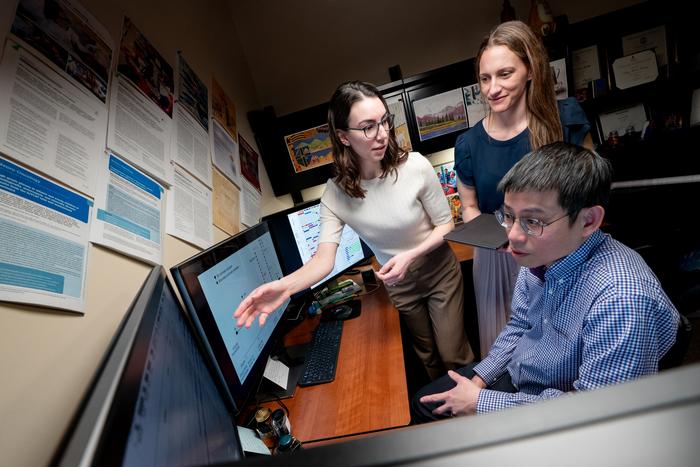
In a groundbreaking development that challenges established conventions in neuro-oncology, researchers at St. Jude Children’s Research Hospital have unveiled compelling evidence showing that the activation of the oncogene FOXR2 is not confined solely to central nervous system (CNS) neuroblastoma, as previously believed, but rather manifests across a broader spectrum of pediatric brain tumors. This discovery signals a paradigm shift in how clinicians diagnose and treat childhood brain cancers, suggesting that the reliance on FOXR2 activation as an exclusive biomarker for CNS neuroblastoma could potentially overlook other aggressive brain tumor types.
Traditionally, the World Health Organization’s classification of CNS tumors has emphasized the distinctive genetic expression patterns that define tumor subtypes, with FOXR2 gene activation considered a hallmark specific to neuroblastoma within the CNS. Neuroblastoma is a type of embryonal tumor primarily affecting children, known for exhibiting relatively favorable responses to multimodal therapy. However, the investigative team led by Dr. Jason Cheng-Hsuan Chiang, MD, PhD, of St. Jude’s Department of Pathology, encountered a recurrent brain tumor in a pediatric patient that defied this classification. The tumor exhibited FOXR2 activation despite not being a neuroblastoma, prompting a comprehensive genomic investigation into FOXR2’s role in other brain tumor entities.
Leveraging the extensive genomic datasets housed within the St. Jude Cloud — a rich repository encompassing whole genome, whole exome, and transcriptome (RNA) sequencing data from a large cohort of pediatric patients — the researchers conducted a systematic search for FOXR2 activation signatures across various tumor types. The results were striking: among 41 patients, 42 tumors demonstrated FOXR2 activation, but only 11 conformed to the expected classification of CNS neuroblastoma. The remaining 31 tumors comprised a heterogeneous group that included high-grade gliomas, pineoblastomas, and several other rare embryonal tumors. This broader occurrence of FOXR2 activation across multiple tumor types suggests a heretofore unrecognized molecular commonality that transcends traditional diagnostic boundaries.
High-grade gliomas, for instance, represent some of the most aggressive malignant brain tumors in pediatric populations, frequently associated with dismal clinical outcomes and limited treatment options. The identification of FOXR2 activation in such malignancies is particularly alarming, given the oncogene’s putative role in promoting tumorigenicity through mechanisms that remain to be fully elucidated. FOXR2 belongs to the forkhead box family of transcription factors, which are known to regulate critical cellular processes including proliferation, differentiation, and survival. Aberrant activation of FOXR2 may thus drive oncogenic pathways that fuel tumor growth and resistance to therapy, underscoring the urgency of understanding the functional consequences of its expression in diverse tumor contexts.
Clinically, the differentiation between CNS tumor subtypes guides therapeutic decisions and prognostic counseling. Emily Hanzlik, MD, co-first author and researcher at St. Jude’s Department of Pediatric Medicine, highlights the stark divergence in outcomes observed within the cohort: while pediatric CNS neuroblastomas with FOXR2 activation responded favorably to aggressive multimodal treatment approaches encompassing surgery, chemotherapy, and radiation, other FOXR2-positive tumors, notably high-grade gliomas and pineoblastomas, displayed poor responses and reduced survival rates. This clinical heterogeneity challenges the notion of using FOXR2 activation as a solitary biomarker and advocates for integrative diagnostic strategies that combine molecular profiling with histopathological and imaging data.
On a molecular diagnostic level, one of the significant hurdles has been the difficulty in reliably detecting the genomic alterations that lead to FOXR2 activation using standard assays. The research team’s meticulous interrogation of complex genomic data revealed diverse and cryptic mechanisms underpinning FOXR2 upregulation, including structural variants and subtle genomic rearrangements undetectable by conventional methods. Co-first author Dr. Alexa Siskar, PhD, from St. Jude’s Department of Pathology, emphasizes that uncovering these intricate genomic events opens new avenues for diagnostic refinement and precision medicine, enabling clinicians to identify FOXR2 activation across a spectrum of tumor types with greater accuracy.
This revelation underscores the broader imperative within neuro-oncology to aggregate multifaceted data layers—encompassing DNA and RNA sequencing results, detailed histologic examination, and advanced neuroimaging—to yield a comprehensive understanding of tumor biology. Dr. Chiang stresses that a holistic diagnostic paradigm is indispensable for delineating tumor subtypes, predicting clinical trajectories, and customizing therapeutic regimens to achieve optimal outcomes. As such, the once seemingly straightforward link between FOXR2 activation and CNS neuroblastoma has become a multidimensional puzzle prompting a reassessment of both laboratory and clinical practices.
The study’s findings accession from St. Jude’s extensive patient data repository highlight the transformative potential of integrating high-resolution genomic data with clinical observation to unveil rare and previously uncharacterized oncogenic phenomena. Ultimately, these insights may translate to more precise molecular stratification of pediatric brain tumors, guiding the development of targeted therapies and improving patient prognoses. As knowledge accrues about FOXR2’s oncogenic roles across distinct tumor types, the research community anticipates novel opportunities to interfere with its function therapeutically.
Moreover, the confirmation that FOXR2 is activated in a wider group of pediatric brain tumors raises vital questions about the underlying molecular drivers and their interactions with tumor microenvironments. The heterogeneity of genetic alterations leading to FOXR2 activation hints at complex regulatory networks, with potential involvement of epigenetic modifications and cooperation with other oncogenic pathways. Decoding this regulatory circuitry is essential for understanding tumor genesis and identifying vulnerabilities amenable to pharmacologic intervention.
In the emerging landscape of pediatric neuro-oncology, embracing such nuanced molecular insights challenges longstanding diagnostic orthodoxy and exemplifies the shift toward precision oncology. As Dr. Hanzlik notes, the implications extend beyond academic comprehension to real-world patient care: better molecular characterization ensures that pediatric patients receive accurately tailored therapies aligned with the biological behavior of their tumors, thereby maximizing efficacy while minimizing unnecessary toxicity.
Funding for this pivotal research was provided through grants from prominent institutions including the National Cancer Institute, the V Foundation for Cancer Research, and ALSAC—the fundraising arm of St. Jude Children’s Research Hospital—reinforcing the hospital’s commitment to advancing cutting-edge pediatric cancer biology. Collaborative efforts involving multiple institutions and investigators have enriched the study’s breadth and impact, underscoring the importance of interdisciplinary cooperation in unraveling complex oncologic phenomena.
St. Jude Children’s Research Hospital, a uniquely dedicated pediatric oncology center recognized as a National Cancer Institute-designated Comprehensive Cancer Center, continues to spearhead innovative research that revolutionizes the understanding, diagnosis, and treatment of childhood cancers. Its leadership in pediatric cancer genomics contributes to elevating survival rates and improving quality of life for patients worldwide, demonstrating how integrating molecular science with clinical care can resonate on a global scale.
As the scientific community digests these critical findings about FOXR2 activation’s broader roles, future research directions include validating these observations in larger cohorts, exploring therapeutic targeting of FOXR2 pathways, and refining molecular diagnostics to incorporate newly discovered genomic alterations. This landmark study illustrates the dynamic nature of cancer biology and the ongoing quest to decode its complexities to benefit patients—a pursuit that remains at the heart of St. Jude’s mission.
Subject of Research: Pediatric Brain Tumors and FOXR2 Oncogene Activation
Article Title: FOXR2 activation is not exclusive of CNS neuroblastoma
News Publication Date: 15-Apr-2025
Web References:
St. Jude Cloud
Neuro-Oncology Journal Article
St. Jude Research Laboratory – Jason Chiang
St. Jude Department of Pathology
St. Jude Department of Pediatric Medicine
St. Jude Children’s Research Hospital
References:
Chiang J.C-H., Hanzlik E., Siskar A., et al. FOXR2 activation is not exclusive of CNS neuroblastoma. Neuro-Oncology, 2025. DOI: 10.1093/neuonc/noaf076.
Image Credits: St. Jude Children’s Research Hospital
Keywords: Brain tumors, Neuroblastoma, Central nervous system, Oncogenes, Cancer genomics, FOXR2 activation, Pediatric oncology, High-grade gliomas, Pineoblastomas, Genomic diagnostics, Pediatric brain cancer, Molecular pathology
Tags: biomarkers for childhood brain cancerschallenges in CNS tumor classificationFOXR2 activation in pediatric brain tumorsgenomic investigation of brain tumorsimplications for brain tumor treatmentinterdisciplinary approaches to brain tumor researchneuro-oncology research advancementsneuroblastoma genetic expression patternsoncogenes and brain tumorspediatric brain cancer diagnosticsprecision medicine in pediatric oncologySt. Jude Children’s Research Hospital studies





